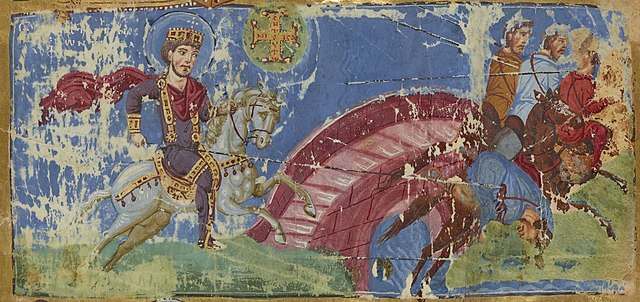Christianity in the 4th century
Christianity in the 4th century was dominated in its early stage by Constantine the Great and the First Council of Nicaea of 325, which was the beginning of the period of the First seven Ecumenical Councils (325–787), and in its late stage by the Edict of Thessalonica of 380, which made Nicene Christianity the state church of the Roman Empire.
Silver ring with Chi Rho symbol found at a 4th century Christian burial site in Late Roman Tongeren, one of the oldest proofs of a Christian community in Belgium, Gallo-Roman Museum (Tongeren)
Emperor Constantine presents a representation of the city of Constantinople as tribute to an enthroned Mary and baby Jesus in this church mosaic. St Sophia, c. 1000.
Icon depicting Emperor Constantine, center, accompanied by the Church Fathers of the 325 First Council of Nicaea, holding the Nicene Creed in its 381 form.
Early manuscript illustration of Council of Constantinople
Constantine the Great and Christianity
During the reign of the Roman Emperor Constantine the Great, Christianity began to transition to the dominant religion of the Roman Empire. Historians remain uncertain about Constantine's reasons for favoring Christianity, and theologians and historians have often argued about which form of early Christianity he subscribed to. There is no consensus among scholars as to whether he adopted his mother Helena's Christianity in his youth, or, as claimed by Eusebius of Caesarea, encouraged her to convert to the faith he had adopted.
Constantine's vision and the Battle of the Milvian Bridge in a 9th-century Byzantine manuscript.
Jugate gold multiple issued by Constantine at Ticinum in 313, showing the emperor and the god Sol, with Sol also depicted in his quadriga on Constantine's shield.
Follis issued by Constantine at Lugdunum c. 309–310, with Sol holding a globe and wearing a radiant crown. Constantine is described as SOLI INVICTO COMITI, 'Companion of Sol Invictus'
The Emblem of Christ Appearing to Constantine, as imagined by Rubens (1622). Constantine's army sees a chi-rho in the daytime sky.







